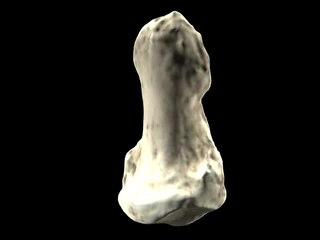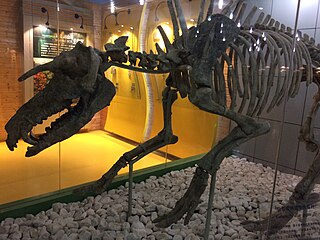
Gladys Louise Smith, known professionally as Mary Pickford, was a Canadian-American film actress, producer, screenwriter and film studio founder. A pioneer in the American film industry with a Hollywood career that spanned five decades, Pickford was one of the most popular actresses of the silent film era. Beginning her film career in 1909, by 1916 Pickford became Hollywood's first millionaire, and at the height of her career had complete creative control of her films and was one of the most recognizable women in the world. Due to her popularity, unprecedented international fame, and success as an actress and businesswoman, she was known as the "Queen of the Movies". She was a significant figure in the development of film acting and is credited with having defined the ingénue type in cinema, a persona that also earned her the nickname "America's Sweetheart".

Orrorin is an extinct genus of primate within Homininae from the Miocene Lukeino Formation and Pliocene Mabaget Formation, both of Kenya.

Megistotherium is an extinct genus of hyaenodont belonging to the family Hyainailouridae that lived in Africa.
Bathyergoides is an extinct genus of rodent from Africa thought to be related to the modern blesmols. It is the only member of the family Bathyergoididae. Fossils of Bathyergoides neotertiarius were recovered from the Early Miocene Elisabeth Bay Formation of Namibia.

The Sealed Room is an eleven-minute film released in September 1909. Produced by the Biograph Company and directed by D. W. Griffith, the drama's cast includes Arthur V. Johnson, Marion Leonard, Henry B. Walthall, Mary Pickford, and Mack Sennett. It was distributed to theaters on a split-reel with another film, the three-minute comedy short The Little Darling.

Kubanochoerus is an extinct genus of large, long-legged suid artiodactyl mammal from the Miocene of Eurasia and Africa.

Martin Pickford is a lecturer in the Chair of Paleoanthropology and Prehistory at the Collège de France and honorary affiliate at the Département Histoire de la Terre in the Muséum national d'Histoire. In 2001, Martin Pickford together with Brigitte Senut and their team discovered Orrorin tugenensis, a hominid primate species dated between 5.8 and 6.2 million years ago and a potential ancestor of the genus Australopithecus.

Huck and Tom is a surviving American comedy-drama film directed by William Desmond Taylor and released in 1918. The scenario by Julia Crawford Ivers is derived from Mark Twain's novels The Adventures of Tom Sawyer (1876) and The Adventures of Huckleberry Finn (1884). Robert Gordon and Jack Pickford reprise the title roles from the 1917 version of Tom Sawyer, a successful adaptation that was also directed by Taylor.
Megalochoerus is an extinct genus of large and long-legged pig-like animals from the Miocene of Africa.

Chleuastochoerus is an extinct genus in the pig family that lived in the Miocene and Pliocene in Russia and Eastern Asia.

Jordan Lee Pickford is an English professional footballer who plays as a goalkeeper for Premier League club Everton and the England national team.
The Little Darling is a 1909 comedy short produced by the Biograph Company of New York and directed by D. W. Griffith. It was released to theaters on a split-reel with Griffith's eleven-minute drama The Sealed Room. The production was filmed in two days–July 27 and August 3, 1909–and at two locations: on interior sets in Biograph's Manhattan studio at 11 East 14th Street and on location at Cuddebackville, New York.
Sinapriculus was an extinct genus of even-toed ungulates that existed in China during the Miocene.

Hyainailouridae ("hyena-cats") is a family of extinct predatory mammals within the superfamily Hyainailouroidea within extinct order Hyaenodonta. Hyaenodontids arose during the middle Eocene and persisted well into the middle Miocene. Fossils of this group have been found in Asia, Africa, North America and Europe.

Teratodontinae is a subfamily of extinct hyaenodonts. Fossil remains of these mammals are known from Middle Eocene to Late Miocene deposits in Africa, the Arabian Peninsula, and Asia.
The Elisabeth Bay Formation, alternatively spelled as Elizabeth Bay Formation, is an Early Miocene geologic formation in the Sperrgebiet, ǁKaras Region of southwestern Namibia, overlying the Blaubok Conglomerate. The freshwater green and red siltstones, sandstones, intercalations of conglomerates and claystones of the formation were deposited in a fluvial environment, infilling a paleovalley incised during the Oligocene low sea stand, which backfilled during the Burdigalian marine transgression. The Elisabeth Bay Formation provides many fossil mammals, snakes and other reptiles.
"Crocodylus" gariepensis is an extinct species of crocodile that lived in southern Africa during the Early Miocene about 17.5 million years ago (Ma). Fossils have been found along a bank of the Orange River in Namibia, near its border with South Africa.

Dissopsalini is an extinct tribe of teratodontid hyaenodonts. Fossil remains of these mammals are known from early to late Miocene deposits in Asia and Africa.

Hyainailourinae ("hyena-cats") is an extinct subfamily of hyainailourid hyaenodonts that lived in Africa, Asia, North America and Europe from the middle Eocene to middle Miocene. They appeared in Africa about 47.8 Ma ago and soon after spread as far as East Asia.
Namafelis is an extinct genus of felids that lived in what is now Namibia during the Early Miocene. It contains a single species, Namafelis minor. Closely related to Diamantofelis, it is of “Pseudaelurus-grade”, and therefore a rather basal member of the cat family.













